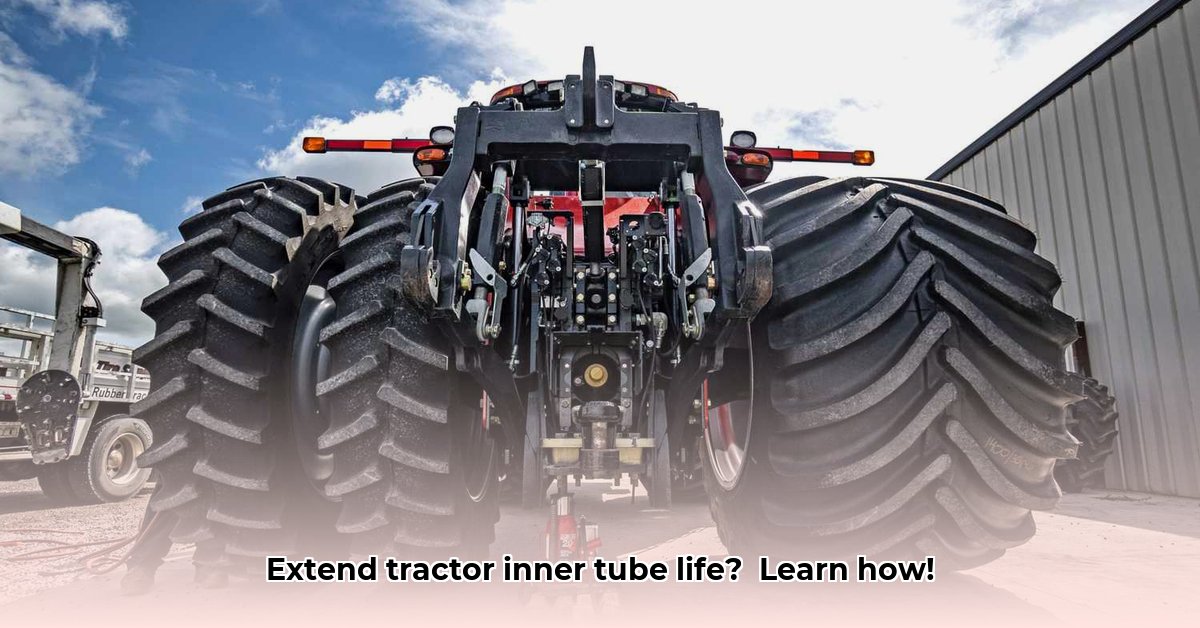
Huge Tractor Inner Tubes: A Practical Guide to Sustainability
Big tractor tires are a substantial investment, and their inner tubes are critical components ensuring smooth, efficient farm operations. Protecting these workhorses isn't just about avoiding costly breakdowns; it's also about implementing smart, sustainable farming practices that benefit both your bottom line and the environment. This guide provides actionable steps to extend the life of your tractor inner tubes, ultimately contributing to a more sustainable agricultural future. For more on tractor tire care, see this helpful resource: Tractor Tire Info.
Understanding Your Giant Tubes: A Closer Look
Before diving into maintenance, understanding your inner tubes is crucial. What material are they made of? (Different rubber compounds offer varying durability.) Always consult the manufacturer's specifications for the correct inflation pressure – this is paramount for optimal performance and longevity. Regular inspections are essential; think of your tubes as the lifeblood of your tractor – a small cut today could lead to significant problems later. Look for cuts, bulges, or any irregularities.
Preventing Problems: Proactive Maintenance Strategies
Prevention is always cheaper and more efficient than repair. Here's a practical plan to keep your tubes in top condition:
Weekly Air Pressure Checks: Using a reliable pressure gauge, check inflation weekly. Consistent, correct inflation prevents uneven wear and premature failure. Underinflation generates excessive heat, damaging the tube. Overinflation weakens it.
Regular Cleaning: Dirt, rocks, and debris are major threats. Clean your tires after each use to remove potential puncture hazards. Prevent dirt buildup.
Thorough Visual Inspections: Before every use, visually inspect tires and tubes for embedded objects, unusual wear patterns, or anything amiss. Early problem detection prevents major issues.
Adhere to Inflation Recommendations: Always inflate tires to the manufacturer's specified pressure. Don't guess – consult your manual or online resources.
Proper Storage: When not in use, store tires and tubes in a cool, dry area, away from direct sunlight and potential hazards. Sunlight degrades rubber over time.
Addressing Damage: Repair and Replacement
Despite preventative measures, damage can occur. Small issues are often repairable, while larger problems may necessitate professional help.
Minor Punctures: Utilize a high-quality repair kit specifically designed for heavy-duty tires. Follow instructions diligently; a poorly applied patch is worse than none.
Significant Damage: Substantial damage typically requires tube replacement. Continuing to operate with a compromised tube is risky and may cause further damage.
Seeking Expert Assistance: If you're unsure about the extent of damage or the repair process, consult a tire specialist. They possess the expertise and tools for proper repair.
Sustainable Practices: Long-Term Strategies
Extending tube lifespan benefits both your finances and the environment. Consider these strategic approaches:
Tire Pressure Monitoring Systems (TPMS): For farms with multiple tractors, TPMS offers significant advantages. Real-time pressure monitoring instantly alerts you to any drops, preventing major issues and downtime.
Exploring Advanced Tire Technologies: Tire technology is constantly evolving. Research advancements like low-pressure tires, which can reduce soil compaction (beneficial for fields and the environment) and potentially improve fuel efficiency.
Responsible Recycling: When tubes reach the end of their life, prioritize environmentally sound disposal. Explore rubber recycling options or companies specializing in tube repurposing.
Choosing the Right Inner Tube: Brand Considerations
Not all inner tubes are created equal. Certain brands demonstrate superior reliability. Switching to a reputable brand with a proven track record can significantly extend tube life. Research reviews and consult fellow farmers for valuable insights.
Improving Inner Tube Sustainability: A Systemic Approach
Addressing inner tube failures requires a collaborative effort. Farmers should report problems to retailers and manufacturers. Retailers should implement rigorous quality checks on incoming shipments. Manufacturers must enhance quality control and manufacturing processes. This collaborative approach necessitates open communication, data sharing, and a commitment to improving industry standards.
The Future of Sustainable Agriculture: Innovative Solutions
The agricultural industry needs to explore alternative tire technologies. More durable materials and innovative designs can considerably increase lifespan and reduce waste. This requires ongoing investment in research and development, driving innovation in the sector. What materials offer the highest resistance to harsh conditions? How can we optimize designs for improved stress handling? These are critical considerations moving forward.
Conclusion: Investing in a Sustainable Future
Improving inner tube sustainability is not solely about cost savings; it's about ensuring operational efficiency and minimizing environmental impact. Every failed tube represents wasted resources and unnecessary downtime. By adopting the proactive strategies outlined in this guide – from diligent maintenance to collaborative industry efforts – we can cultivate a more sustainable and efficient agricultural future.